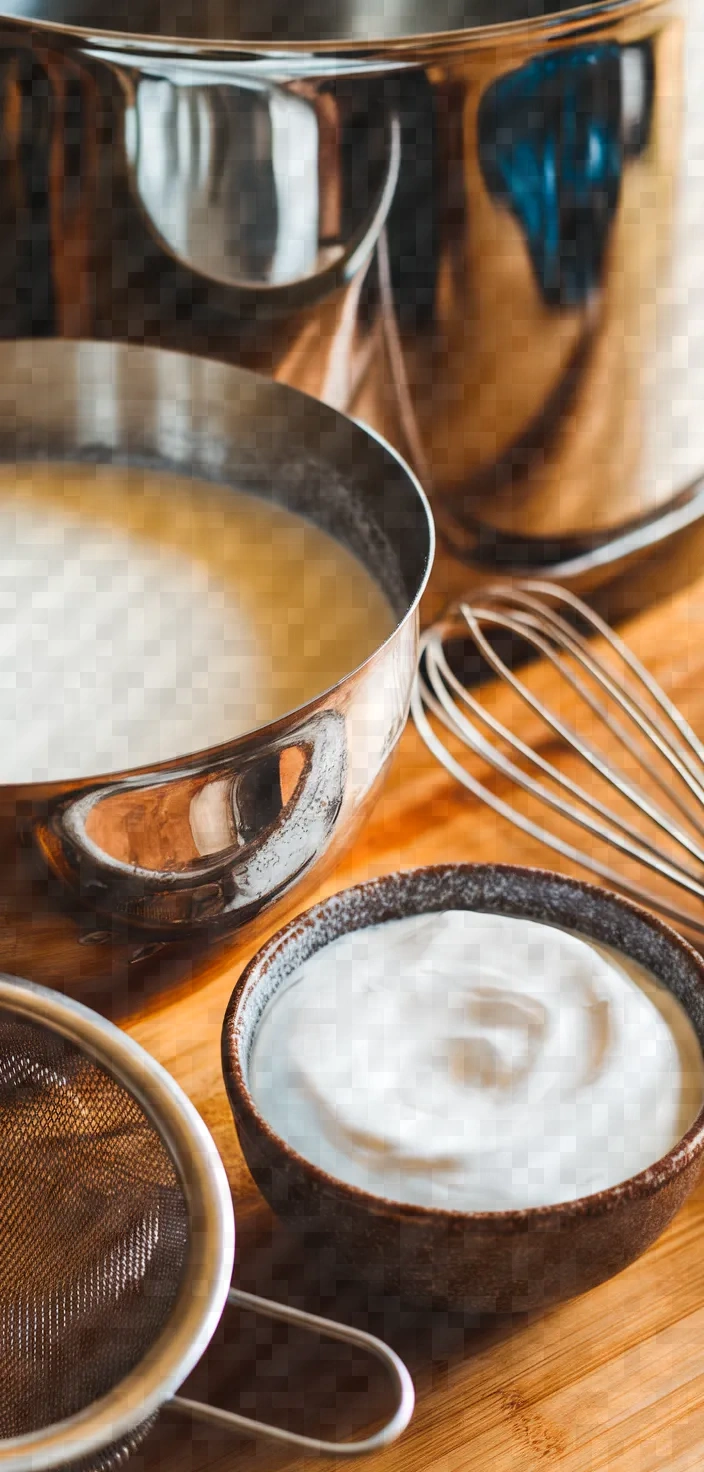Isn’t it amazing how transforming a humble gallon of milk into creamy, luscious Greek yogurt feels like a mini kitchen miracle, all with just a little patience and the right know-how?

Crafting thick and creamy Greek yogurt at home is something I love to do. With just a gallon of whole milk and some starter yogurt, it’s simpler than you might think.
My method uses very basic kitchen tools: a pot, and an instant-read thermometer. Yogurt has a huge probiotic boost (and I like to think that it’s as close to a health food as you can get without actually chewing on a carrot).
It’s also wonderfully rich in protein.
Thick Homemade Greek Yogurt Recipe Ingredients

- Whole Milk: Creamy base; rich in protein and calcium.
- Plain Greek Yogurt: Probiotic booster; adds tang and thickness.
Thick Homemade Greek Yogurt Recipe Ingredient Quantities
- 1 gallon of whole milk
- 1/2 cup of plain Greek yogurt with active cultures (for starter)
- Equipment: Instant-read thermometer, large pot, whisk, strainer, cheesecloth or nut milk bag
How to Make this Thick Homemade Greek Yogurt Recipe
1. Place the whole milk in a large pot and turn the heat to medium. Stir the milk occasionally as it warms.
2. An instant-read thermometer is your best bet for monitoring the temperature. Heat the milk to 180 degrees Fahrenheit (82 degrees Celsius). It should not boil. If it does, you have heated it too fast. This is a critical step for achieving thick yogurt, as it helps denature the proteins. If you want to get really technical with it, the proteins in milk act like coiled springs. When they are denatured, they unfold.
3. Take the pot off of the heat, and let it sit until the milk has cooled to 110°F (43°C). This is the chef-recommended saucing temperature for adding the starter.
4. After the milk has cooled, take 1/2 cup of plain Greek yogurt and whisk it into a small amount of the warm milk until smooth.
5. Yogurt and milk mixture return to the pot with the milk. Whisk thoroughly.
6. Pour the concoction into a tidy vessel, or retain it in the saucepan. Enshroud it with a pristine cloth or the pot’s lid.
7. Keep the yogurt warm for 6 to 12 hours at around 100°F (38°C) to incubate it. You might use an oven with the light on or a yogurt maker for this purpose. If you let it go longer, you’ll end up with a tangy-er product.
8. After the yogurt has reached the desired taste and thickness, take a strainer and line it with cheesecloth (or use a nut milk bag), and place it over a large bowl.
9. Put the yogurt into a strainer to drain the whey. Let it strain for several hours or until it reaches your preferred thickness.
10. Thickened yogurt should be placed in an airtight container and chilled. Use it to enjoy homemade Greek yogurt, and you’ll find no reason to return to the store-bought kind. It’s delightful with fruits, honey, or as a base for savory dishes.
Thick Homemade Greek Yogurt Recipe Equipment Needed
1. Large pot
2. Instant-read thermometer
3. Whisk
4. Small bowl
5. Tidy vessel or saucepan (to hold the yogurt during incubation)
6. Cloth or pot’s lid (to cover during incubation)
7. Oven or yogurt maker (for incubation)
8. Strainer
9. Cheesecloth or nut milk bag
10. Large bowl
11. Airtight container
FAQ
- Q: Can I use low-fat milk instead of whole milk?A: Yes, you can use low-fat milk; the yogurt just won’t have the same creaminess and thickness as it does when you use whole milk.
- Q: How do I know when the yogurt is ready?A: When it thickens and sets, the yogurt is ready, which usually takes 6 to 12 hours. How fast it sets and thickens depends on the temperature and starter culture.
- Q: Do I need to boil the milk?To eliminate any undesirable bacteria and to ensure the yogurt thickens correctly, the milk must be heated to about 180°F. You might already know this, but it helps to state it plainly: If you heat the milk to the wrong temperature, you risk ending up with runny yogurt.
- Q: Can I reuse store-bought yogurt as a starter?A: Yes, as long as there are active cultures. But, ensure that what you’re using is plain yogurt with no flavorings or add-ins.
- Q: How long can I store homemade Greek yogurt?A: You can keep homemade Greek yogurt in the fridge for as long as 2 weeks. To get the best results and an optimal shelf life, store it in an airtight container.
- Q: How do I make sure the yogurt is thick enough?A: Use cheesecloth or a nut milk bag to strain the yogurt. This will remove excess whey and provide the thickness desired for the finished yogurt.
Thick Homemade Greek Yogurt Recipe Substitutions and Variations
1 gallon of low-fat milk can be used in place of 1 gallon of whole milk for a lighter version.
1/2 cup of Greek yogurt that is plain and contains active cultures can be swapped out for 1/2 cup of another type of yogurt that has live cultures, such as regular yogurt that is plain.
A clean, thin kitchen towel or a double layer of thick, strong paper towels can take the place of cheesecloth or a nut milk bag.
Pro Tips
1. Consistent Stirring While heating the milk, stir it occasionally and gently to ensure even heating and to prevent the milk from sticking to the bottom of the pot. This will help avoid scorching, which can affect the taste of your yogurt.
2. Temperature Precision Use an instant-read thermometer to precisely monitor the milk’s temperature. Heating the milk to exactly 180°F (82°C) and cooling it to exactly 110°F (43°C) is crucial for achieving the right texture and for effective fermentation when the starter culture is added.
3. Starter Freshness Ensure that the plain Greek yogurt you use as a starter is as fresh as possible and contains active live cultures. Fresh cultures are pivotal for successful fermentation and thickening your yogurt.
4. Incubation Environment Maintaining a stable temperature during incubation (around 100°F or 38°C) is key for optimal fermentation. If using an oven, periodically check the temperature as the light can sometimes vary in heat output. Alternatively, a yogurt maker can offer consistent warmth.
5. Control Thickness and Tanginess If you prefer thicker yogurt, extend the straining time beyond standard instructions until you reach the desired consistency. For tangier yogurt, extend the incubation period, but balance this with close monitoring to avoid over-fermentation.

Thick Homemade Greek Yogurt Recipe
My favorite Thick Homemade Greek Yogurt Recipe
Equipment Needed:
1. Large pot
2. Instant-read thermometer
3. Whisk
4. Small bowl
5. Tidy vessel or saucepan (to hold the yogurt during incubation)
6. Cloth or pot’s lid (to cover during incubation)
7. Oven or yogurt maker (for incubation)
8. Strainer
9. Cheesecloth or nut milk bag
10. Large bowl
11. Airtight container
Ingredients:
- 1 gallon of whole milk
- 1/2 cup of plain Greek yogurt with active cultures (for starter)
- Equipment: Instant-read thermometer, large pot, whisk, strainer, cheesecloth or nut milk bag
Instructions:
1. Place the whole milk in a large pot and turn the heat to medium. Stir the milk occasionally as it warms.
2. An instant-read thermometer is your best bet for monitoring the temperature. Heat the milk to 180 degrees Fahrenheit (82 degrees Celsius). It should not boil. If it does, you have heated it too fast. This is a critical step for achieving thick yogurt, as it helps denature the proteins. If you want to get really technical with it, the proteins in milk act like coiled springs. When they are denatured, they unfold.
3. Take the pot off of the heat, and let it sit until the milk has cooled to 110°F (43°C). This is the chef-recommended saucing temperature for adding the starter.
4. After the milk has cooled, take 1/2 cup of plain Greek yogurt and whisk it into a small amount of the warm milk until smooth.
5. Yogurt and milk mixture return to the pot with the milk. Whisk thoroughly.
6. Pour the concoction into a tidy vessel, or retain it in the saucepan. Enshroud it with a pristine cloth or the pot’s lid.
7. Keep the yogurt warm for 6 to 12 hours at around 100°F (38°C) to incubate it. You might use an oven with the light on or a yogurt maker for this purpose. If you let it go longer, you’ll end up with a tangy-er product.
8. After the yogurt has reached the desired taste and thickness, take a strainer and line it with cheesecloth (or use a nut milk bag), and place it over a large bowl.
9. Put the yogurt into a strainer to drain the whey. Let it strain for several hours or until it reaches your preferred thickness.
10. Thickened yogurt should be placed in an airtight container and chilled. Use it to enjoy homemade Greek yogurt, and you’ll find no reason to return to the store-bought kind. It’s delightful with fruits, honey, or as a base for savory dishes.















